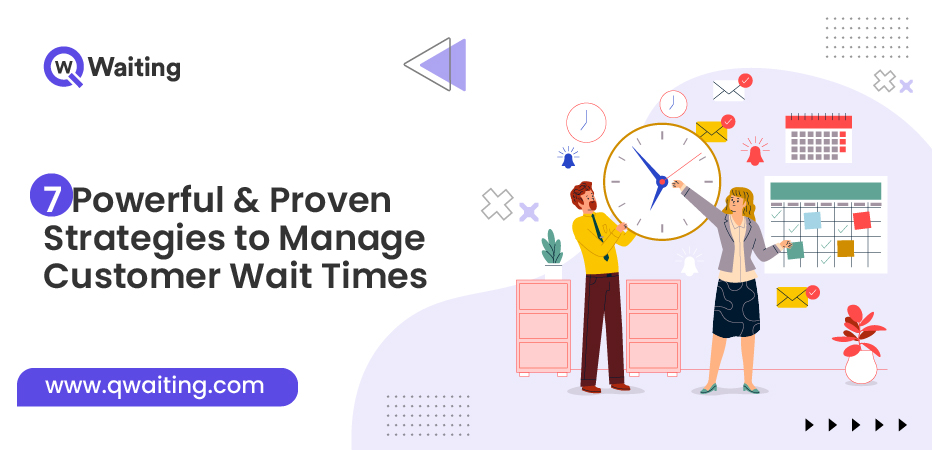
For every business, customer satisfaction is of supreme importance in driving success. However, one of the critical challenges faced by businesses is managing customer wait times while availing services.
Whether it’s experiencing a long queue at a store, a delay in customer service response, dealing with a slow-loading website, or more. These moments of waiting can quickly lead to frustration & disappointment for customers, which leads to the risk of losing a valuable clientele base.
Fortunately, in this dynamic era where customer satisfaction is paramount, businesses have developed proven strategies to effectively manage customer wait times.
By implementing these strategies, businesses can make a balance between customer expectations and operational efficiency, ensuring a positive experience for both parties involved.
In this write-up, we will explore innovative techniques that can transform waiting into an opportunity for engagement, loyalty, and overall customer delight.
Effective Approaches To Handling Customer Wait Times With Proficiency
Managing customer wait times is important for providing a positive and better customer experience. Here are seven proven strategies to help you effectively manage customer wait times:
Create A Pleasant Waiting Area

Design a comfortable and inviting waiting area for your customers to manage long waiting hours. You should provide a range of comfortable seating options to cater to the different preferences of your customers.
Also, design the waiting room in a way that respects customers’ privacy and personal space. Provide dividers between each seating area to create a sense of privacy & ensure that seats are not too close together to avoid overcrowding.
Use warm lighting fixtures and create a soothing ambiance that significantly helps to create a welcoming atmosphere. Ensure the area remains clean and temperature-controlled at all times. Offer complimentary beverages and free Wi-Fi access to customers to make their wait more enjoyable.
Integrate Efficient Customer Waiting System
The most powerful strategy to manage customer wait time is to deploy a line queue system in your business premises. This system helps you organize and prioritize customer requests, ensuring a smooth and orderly flow.
It provides real-time updates to customers regarding their queue status and average wait times, which reduces customer frustration.
Also, it informs the customers about any delays or changes in the wait time to manage their expectations effectively. The system records historical data to determine the optimal number of staff needed to serve customers seamlessly at different times of the day. So, the staffing levels can be adjusted accordingly to minimize wait times.
Additionally, the queue system helps gather customer feedback, identifying areas for improvement and enhancing overall efficiency.
Offer Self-Service Options For Customers

Businesses can integrate self-service solutions, such as kiosks or online portals, where customers can perform specific tasks themselves without relying on staff assistance.
For instance, they can place orders, make reservations, or check account information at their own pace and convenience. By eliminating the need to wait in long queues & interact with staff for simple tasks, customers can save time & have a more streamlined experience.
This allows customers to bypass lines and complete their tasks more quickly and efficiently. Moreover, it is crucial to provide clear instructions to customers who may not be familiar with self-service options to prevent any confusion.
Train And Empower Staff

Employees are the ones who create the customer experience. Therefore, it is essential to provide comprehensive training to ensure they have the necessary skills to handle customer inquiries efficiently & improve the waiting experience.
They possess the ability to make quick decisions and resolve customer queries efficiently, which ultimately helps to reduce customer overall wait time. Train them in customer service skills, effective communication, conflict resolution, and more for effective outcomes and positive customer experience.
Set Clear Expectations
To effectively manage customer wait times and minimize frustration, it is crucial to accurately estimate and communicate the expected wait period. This can be achieved through various methods such as digital signage or notifications.
For example- Imagine you visit a popular theme park during peak season. To handle the large crowds & ensure a positive experience, the park displays estimated wait times for each ride at various locations throughout the park.
These wait times are regularly updated based on real-time data and are communicated to visitors through mobile apps and signs. By setting clear wait time expectations, the park helps visitors plan their day accordingly and make informed decisions about which rides to prioritize.
Offer Engaging Entertainment
When it comes to efficiently handling customer wait times, offering engaging distractions and entertainment can be an effective approach.
One way to achieve this is by providing reading materials like magazines or newspapers for customers to read. It’s essential to have a variety of manual genres available on the table to cater to different interests and age groups.
Another option is to set up televisions in your waiting area, showcasing entertaining content such as news or interesting videos. Additionally, you can display promotional content related to your products or services to inform and engage customers while they wait.
Collect And Analyze Data

The customer queue management system helps to collect, monitor, track, and analyze data related to customer wait times.
By leveraging this system, businesses can gain valuable insights into average wait times, peak hours, and customer feedback. This information enables data-driven decision-making and the optimization of customer wait time management strategies.
Qwaiting- The Best Option To Minimise Customer Waiting Hours
Qwaiting is an advanced queuing system that aims to enhance the customer waiting line experience and improve the overall customer experience. It helps to optimize the queuing process and provide real-time updates to customers.
The following are the pointers that explain how Qwaiting works:
- Qwaiting replaces physical queues with virtual queues, allowing them to engage in other activities while waiting.
- Qwaiting sends automated notifications and alerts to customers, keeping them informed about their queue status.
- Qwaiting can integrate with a mobile app that customers can download on their smartphones. Through the app, customers can join a queue, select their desired service, & receive updates on their position in the queue & estimated waiting time.
- Qwaiting can incorporate self-service options into the system, which allow customers to fill in their information before the service time. This streamlines the process and reduces the time needed for service providers to gather information manually. By the time customers reach the front of the queue, service providers are already prepared to assist them efficiently.
- Qwaiting collects data on waiting times and service efficiency, which can be analyzed to identify bottlenecks and improve operational processes. By leveraging these insights, businesses can make data-driven decisions to further reduce waiting times.
The Winding Up
To conclude, every business is unique, so it’s essential to evaluate your business circumstances & tailor these strategies to best fit your business needs. Regularly review and refine your approaches to continually improve customer wait times and the overall customer experience.
The best strategy to manage customer waiting hours is to implement the customer waiting system into the business model. With the help of the system, businesses can automate their operations and enhance customer satisfaction.
